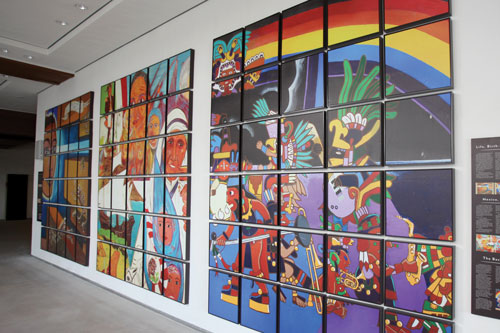Students who wander to the second floor of the Conrad Prebys Aztec Student Union can view artistic echoes of the past. Specifically, tiled photographs of three murals that were painted onto the walls of the original Aztec Center.
The three murals on display were painted by students studying Chicano art during the late 1970s and early 1980s. Each depicts an important facet of Chicano culture, contributing to the promotion of diversity at San Diego State.
The desire to create and preserve art is found in SDSU students across time. When plans to demolish the Aztec Center came to fruition in 2011, students sought to preserve the murals that decorated the center’s walls.
“When we were talking about the new union, and tearing the old one down, the first thing students thought was, ‘How are we going to preserve the remnants of the old union’ and, ‘How are we going to remember it?’” Vice President of External Relations Javier Gomez said.
Because the murals were painted on plaster, the originals unfortunately couldn’t be preserved. That didn’t stop determined students.
“Once we found out they couldn’t be removed, the next thought was, ‘How we do we commemorate these murals in the new union?’” Gomez said. “We took high-resolution photos of the mural so that we could commemorate all three of the murals in the new union as well as the history of the old union.”
“Mexico, the Periods” illustrates the rich history of Mexico while its neighboring mural gives praise to the gods of music. Swirls of yellow and sharp white lines come together in the leftmost mural entitled “Life, Birth-Death and Rebirth.” Designed by Mario Torero, the journey to creation for this mural was a rocky one.
Torero is one of the founding members of Centro Cultural de la Raza, and in 1980, the organization featured Mexican artist Jose Guadalupe Posado. Posado’s artwork is popular for featuring skeletons, and has become synonymous with Dia de los Muertos. At the same time, Torero was teaching a Chicano art class at SDSU. He wanted to end the academic year with a bang and decided that a mural would be the perfect project for him and his students.
“We were so excited about presenting Posado at the Centro that we connected the Centro Cultural to co-sponsor our project, which was to create a mural at SDSU that would celebrate Posado’s artwork in combination with a composition that was created by students at SDSU, specifically the ones in my class,” Torero said.
When Torero submitted his initial design for the mural, administration reacted negatively to it because they found the work to be too morbid. This halted the project altogether. Torero and his supporters rallied against the criticism with petitions.
“Because the whole class of students was involved in creating this, we all campaigned to make it happen,” Torero said. “We convinced the faculty that our design wasn’t in any way offensive, but that it was part of a cultural reflection of Chicanos and our history, and that it should be applied to the school.”

The discussions and protests worked, and in May 1980, Torero’s students finally painted the mural.
As time passed, the mural became lovingly referred to as “The Clock Mural” because of the large clock around which the mural was painted. During the planning for the construction of the new student union, Torero attended meetings in hopes that the art could be preserved.
“It took me months before I could finally get myself together and I was able to then get some members of my community to rally behind me and together we sent a letter to President (Elliot) Hirshman,” Torero said.
Thankfully, Torero’s mural hangs proudly in the student union, and he has plans of installing more art at SDSU. He is currently in the process of planning and designing another mural to be featured on the SDSU campus in collaboration with the SDSU School of Art and Design.
It will be a mural done in glass mosaics, and use “Life, Birth-Death and Rebirth” as “the foundation to create something that is something more contemporary.”
With the display of the mural recreations along with another mural located in Montezuma Hall, the foundation has been laid for the student union to become another hub of culture and art on campus.
“I know that as time progresses I’m sure that there will be more pictured murals on the building because there’s a lot of space on the walls and we want to make the union more homey,” Gomez said.
Photo by Monica Linzmeier, photo editor




